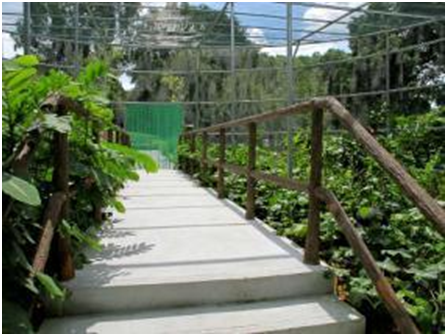Anubias - Not Just for Aquariums!
Anubias is a genus of semi-aquatic plants commonly sold in local aquarium shops for planting up a freshwater aquatic landscape. Of the handful of known species, Anubias barteri and its range of cultivars are most commonly found.
They can be bought potted up on rockwool or tied to volcanic rock or bogwood. Most people grow them underwater (submersed), but these plants generally grow better emersed, that is, with their leaves out of water.
Did you know that Anubias is part of the yam family, Araceae? The genus name is derived from the name of the Egyptian god of the afterlife, Anubis, as these plants are often found growing in shadier parts of marshes and streams in tropical Africa.
Anubias barteri is often overlooked as a plant candidate suitable for growing in terrariums. A number of cultivars, in particular, those of Anubias barteri var. nana are rather small in size and compact in stature. They are rather slow growing and do not need a lot of light . Being semi-aquatic plants, Anubias barteri cultivars thrive under moist and humid conditions that are often encountered inside an enclosed container.
Below is a selection of the more commonly available Anubias barteri cultivars:
Anubias barteri var. nana
Anubias barteri var. nana grows to about 10cm tall. Depending on the size of plants bought for use in the terrarium, smaller specimens of this plant can be used as foreground plants. Larger and more mature specimens can be used as mid-ground plants in the terrarium.

Anubias barteri var. 'Petite'
Anubias barteri var. 'Petite' is the smallest cultivar that grows to about 5cm, with leaves up to 1.5cm long and 0.5cm wide. Due to its slow growth rate and compact size, it is an excellent candidate for small terrariums. In large terrariums, it can be used as a foreground plant as it forms a nice carpet.
Anubias barteri var. nana 'Gold'
This cultivar is unique as it features elliptical leaves that are chartreuse in colour and can be used to confer some colour to the terrarium landscape. Plants bought from the aquarium shop are mostly young plants which can first be grown as a foreground plant and inside small terrariums. These, however, will need to be moved to larger growing confines as they mature.
Anubias barteri ('Coffeefolia')
This cultivar is sometimes known by its unofficial name 'Coffeefolia' due to its unique characteristic of having new leaves that are a reddish-brown colour, but turn into the usual dark green as they mature. Another interesting characteristic of this plant is that it has heavily ridged leaves. It is a slow-growing cultivar which can grow up to about 50cm tall.
How to Grow Anubias in Terrariums
Terrarium Materials
Some tools and materials you need to gather when constructing a terrarium. At the top is a clear container. From left to right - a pair of sharp scissors for trimming plants; a pair of chopsticks that can be used to move plants in tight corners; a spoon to transfer media; aquatic plant growing substrate for propagating plants in; and fine gravel that can be used as a decorative mulch. Finally, at the base of the picture are some pebbles for decoration.
Light Requirements
It is well known that Anubias barteri cultivars do not require a lot of light to thrive. A desk lamp placed around 20cm away from the top of terrarium and is turned on during office hours, in general, supplies sufficient light to keep these plants happy.
Avoid placing an Anubias terrarium in a sunny area, as heat will build up inside the terrarium due to the greenhouse effect as well as overexposure to direct sunlight. This can cause the leaves to bleach into a sickly-yellow colour and in the long run, is detrimental to the health of these plants.
Media
Growing media formulated for growing aquatic plants are recommended for growing Anubias barteri cultivars. ADA Amazonia Aqua Soil, which is commonly available for purchase from major aquarium outlets, is one that is suited for growing these plants. Terrestrial plants can also be grown in this media.
When planting Anubias, one should always bear in mind not to bury the horizontal creeping stem of the plant inside the media. This creeping stem should be exposed and sit just on the surface of the media.
Water
Being semi-aquatic plants, Anubias barteri cultivars are best kept moist at all times. They should never be allowed to dry out. These plants can tolerate a soggy substrate much better than terrestrial plants, hence Anubias barteri cultivars are great for novices who tend to overwater their terrariums. With this in mind, be careful when you combine Anubias barteri cultivars with terrestrial plants when creating a terrarium. Terrestrial plant companions may not be so tolerant of wet conditions.
Feeding
Anubias barteri cultivars do not grow fast and hence are not demanding in terms of their nutrient needs. One can incorporate a few pellets of a coated slow release fertiliser (e.g. Osmocote) into the growing media, or apply an occasional spray of a highly-diluted water-soluble fertiliser (e.g. Phostrogen) onto the surface of the leaves.
By Dr Wilson Wong
| Join us at Gardener's Day Out at HortPark on 8 September 2012 where we have several activities and programmes laid out for you, including a talk on shade plants and terrarium workshop. Visit our website or email us at NParks_HortPark@nparks.gov.sg for more information. |
Have views or comments on this article? Let us know via this form. If you would like to give us feedback on any other areas relating to our parks and gardens, please submit via https://www.nparks.gov.sg/feedback







sage steve 9/29/2015 12:02:21 AM